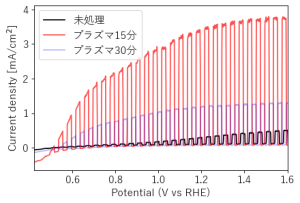金属材料等へのプラズマ照射により、表面にナノ綿毛が形成される現象を利用して様々な応用研究を行っています。金属は酸化物になると半導体になりますが,プラズマ処理により,これまでにない機能性ナノ構造材料金属の創成を行っています。その1つが,太陽光を使った水分解による水素/酸素生成用の電極材の開発です。太陽光を使った水分解は,人工光合成の半反応として知られていますが,問題の1つは太陽光に含まれるエネルギーが高い光しか反応に使えないという欠点です。可視光を使うことができるようになれば,大きなポテンシャルを有しています。本研究室では,可視光応答性を有するタングステン酸化物や鉄酸化物をブラズマ処理で活性を高めることに成功しています。タングステン酸化物では,綿毛化により表面積が著しい増大により活性が大きく向上し(下図)[1],酸化鉄ではプラズマ照射により酸素欠陥を制御することができ,光電気化学反応に必要なポテンシャルが大きく減少することを発見しました[2]。また,プラズマ処理により,酸化チタンによるフードロスに関連しているエチレンの分解の活性が大きく向上することも見出しています[3]。

Enhancement of photocurrent on WO3 by He plasma treatment [1].
We are conducting various application studies using the phenomenon of nano-fuzz forming on the surface of metal materials through plasma irradiation. Metals become semiconductors when they become oxides, and we are creating new functional nano-structured materials through plasma processing. One of these is the development of electrode materials for hydrogen/oxygen generation through water splitting using sunlight. Hydrogen/oxygen production by water splitting using sunlight is known as a part of artificial photosynthesis, but one problem is that only the light with high energy contained in sunlight (ultraviolet) can be used for the reaction. If it becomes possible to use visible light, it will have great potential. In this laboratory, we have succeeded in increasing the activity of tungsten oxide and iron oxide, which are visible light-responsive, by plasma treatment. In the case of tungsten oxides, the activity is greatly improved by the significant increase in surface area due to the formation of a fluffy structure (see figure above) [1], and in the case of iron oxides, we discovered that the oxygen defects can be controlled by plasma irradiation, and that the potential required for photoelectrochemical reactions can be greatly reduced [2]. We have also found that plasma treatment greatly improves the activity of ethylene decomposition, which is related to food loss caused by titanium oxide[3].
関連論文 (Related publication)